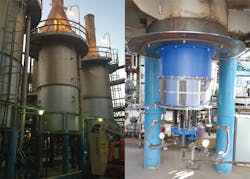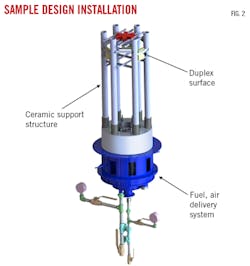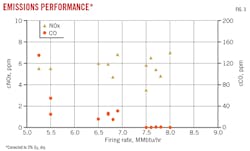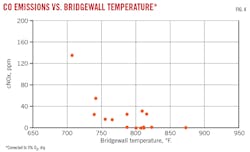Douglas Karkow
Venkatesh Iyer
James Dansie
Donald Kendrick
ClearSign Combustion Corp.
Seattle, Wash.
A California refiner has implemented technology to reduce contents of nitrogen oxides (cNOx) and carbon monoxide (cCO) emissions as part of a retrofitting project at the site.
ClearSign Combustion Corp., Seattle, Wash., successfully retrofitted its Duplex Plug & Play technology in an up-fired process heater at the refinery. Phase 1 of the program achieved sub-6 ppm cNOx and sub-50 ppm content cCO emissions at firing capacities up to 8 MMbtu/hr, with the system turned over to the team trained in its operation.
The system has been optimized and automated to allow refinery operators to achieve desired process throughput, while obtaining best-in-class emissions and no flame-impingement issues, all with the press of a button.
Background
NOx produced during combustion contribute to the formation of smog and acid rain and are harmful to humans. Current NOx-control strategies include reducing O2 for diffusion-style burners, water-steam injection, external flue-gas recirculation, air or fuel staging, premixing, and selective catalytic reduction. All have their merits, but some cannot approach the emissions levels required of today’s strictest regulatory jurisdictions, while others add unnecessary cost and complexity, cause combustion instabilities, or reduce fired efficiency. Stricter regulations proposed for the industrial combustion market include refinery process heaters, boilers, once-through steam generators, and formerly unregulated enclosed-ground flares. ClearSign’s retrofit technology achieves best-in-class emissions (NOx < 6 ppm; CO < 10 ppm, corrected to 3% O2) by burning premixed within porous ceramic.
Premixed combustion within ceramic tiles has numerous advantages compared with conventional burners, including high-power densities, wider operating envelopes, ultralean blowout margins, and ultralow emissions. Flame length also is reduced due to enhanced mixing and heat transfer, allowing increased throughput, improved safety, and reduced equipment-lifecycle costs by mitigating flame impingement on process tubes. The technology also can act as an enabler for opportunity fuels such as low-btu gases, renewables, etc., which typically require complete burner modifications.
Recently, Duplex technology has evolved into a Plug & Play design that integrates the burner, support structure, air register, and ceramic surface in a simple, modular, preengineered package. This design can easily replace existing burners either online (hot swap) or during a planned outage. The new design is ideal for vertical process heaters and can be configured for a variety of gaseous fuels, including natural gas, refinery fuels, and field or waste gas. This paper examines an installation in a process heater at a California refinery that successfully reduced NOx emissions to sub-6 ppm levels and average CO levels well below permitted levels (Fig. 1).
A California refinery’s up-fired process heater was retrofitted with Duplex Plug & Play technology, which reduced NOx emissions to sub-6 ppm levels, corrected to 3% O2, to satisfy current regulatory requirements and eliminating any potential for flame impingement (Fig. 1).
Technology overview
Duplex incorporates a high-temperature porous ceramic matrix positioned a few feet away from the fuel-air injection plane. Fuel and air are thoroughly mixed before reaching the matrix and entrain internal flue gases that dilute the mixture before combustion. The mixture is then ignited by the hot, glowing surface, where the bulk of combustion occurs. To provide an effective means for combustion stabilization, flame confinement, and radiation-heat transfer, the technology operates in three modes (OGJ, Mar. 6, 2017, p. 56).
Cold-furnace startup, warmup. Conventional process heater startup procedures are followed, whereby burner pilots are ignited and verified. Burner ignition then follows, where the heater operates in burner mode (e.g., flames stabilized at the burner throat, tile) during the furnace and Duplex-surface warmup period. The refinery’s standard burner ramp-up and furnace-soaking periods are followed.
Transition. Once the warmup procedure is completed, the surface temperature is verified to ensure it remains above the ignition temperature of the gas as correlated by the heater bridgewall temperature or surface glow. Once ignition temperatures are verified, fuel supply to the warmup burner nozzles is removed, with fuel then supplied to the Duplex nozzles to initiate flame transition.
Operation. Once transition has been accomplished, the heater can be ramped up to its design capacity while operating in Duplex mode.
The new architecture features the same modes of operation as conventional Duplex technology.
Design
System architecture incorporates design improvements beyond those of the original monolithic Duplex surface. Alongside its configuration as a modular burner-retrofit package, the new design employs additional stabilization techniques near the surface.
Fig. 2 shows a novel design of the Duplex architecture, a variant of which was employed for the California refiner’s process and performance needs.
The structural framework of the new modular technology includes a series of lattice members that receive the reactant mixture (Fig. 2). This lattice behaves like a bluff body, providing robust stabilization of the flame. The structure also takes a more three-dimensional shape with porous ceramic surfaces on the periphery and top of the ceramic structure.
This architecture provides two primary benefits. The combination of the bluff body lattice and surrounding radiant porous surfaces encloses the flame volume, effectively creating a very high-temperature zone for robust flame stabilization. Due to the high temperature in this zone, reaction rate is also very high. The expanding combustion gases’ pressure drop increases when trying to escape around the porous surfaces. These factors contribute to a very compact flame volume, making flame impingement on process tubes practically impossible.
Installation, commissioning
In May 2018, ClearSign commissioned its proprietary burner at a California refinery in an up-fired process heater with maximum heater duty of 15 MMbtu/hr. The heater operates at 8 MMbtu/hr for dehydration and up to 15 MMbtu/hr once or twice a year for fractionation.
The project was divided into two phases. Phase 1 involved installation of a new modular 8 MMbtu/hr burner to allow the operator to complete the dehydration process. Emissions targets mandated by the local air quality district were 50 ppm CO and 6 ppm NOx, both corrected to 3% stack O2 (dry). Installation of the system was completed in a single day.
The ceramic structure was assembled, lifted into place, and affixed to the underside of the heater using its dedicated interface plate. The fuel delivery, air registers, and warmup burner components were then assembled and attached. Adding gas interconnects, an ignition system, and valving completed the burner installation process.
The initial commissioning period required manual operation, whereby air and fuel flow rates were adjusted directly to determine proper fuel-air set points and define the optimal performance envelope. Subsequent automated operation used an actuator on the unit’s barrel-style register, along with a fuel-control valve on the fuel-supply line.
During initial commissioning, the excess-O2 range for peak performance of the system was 6-8% (dry), much higher than the stable operating window characterized in ClearSign’s laboratory and other applications. The authors suspect these O2 levels were due to air infiltration. Future furnace sealing is planned to alleviate this issue.
To optimize emissions performance across the broadest operating envelope, ClearSign tested a series of different nozzle configurations to assess their impact on emissions at various firing capacities. The new fuel manifold consists of two independent main-fuel circuits, both independent of the startup-fuel circuit. This configuration provided flexibility during initial commissioning by selecting the number of desired risers (where the new manifolds were located) and their respective port sizes to obtain the required firing capacity out of several possible configurations. The refiner’s flexibility operating this heater enabled ClearSign to collect data at a variety of nozzle configurations and heat-release rates (Fig. 3).
Due to underfiring of the 15 MMbtu/hr-rated heater, the measured bridgewall temperatures were rather low, never exceeding 875° F. and often below 800° F. (Fig. 4). As a result, CO emissions began to rise.
The bridgewall temperature is, in a way, a substitute for the temperature within the combustion zone. Lower bridgewall temperatures correspond to less thermal input supplied to the porous surfaces. These relatively low temperatures increase the residence time required for the oxidation of CO to CO2, which causes an increase in CO emissions at very low bridgewall temperatures (Fig. 4). Based on this knowledge and other data collected, ClearSign was able to select the best configuration for optimal emissions performance up to 8 MMbtu/hr.
Currently, the California refiner is achieving sub-6 ppm NOx emissions up to 8 MMbtu/hr. The automated system performs all modes of operation from light off, to transition, to Duplex operation, including automated air-register positioning for maintaining compliant emissions. The current capacity meets all of the refinery’s production needs, save for a fractionation cycle that occurs once or twice a year and requires firing capacities exceeding 10 MMbtu/hr. The customer has requested a burner scaleup to address these cycles.
Future plans
Data collected during Phase 1 of the project will help determine if modifications are necessary for Phase 2, during which the refiner intends to install a larger system capable of reaching the furnace’s maximum firing rate.
During Phase 2 scheduled for early 2019, design will be scaled up to enable ultralow emissions performance up to the maximum duty of the refinery’s furnace of 15 MMbtu/hr, a firing rate that this refinery’s heater has not achieved in decades.
The authors
Douglas Karkow ([email protected]) is director of Duplex technology for ClearSign Combustion Corp., Seattle, Wash., where he has led research, experimentation, and development of the company’s novel technology since 2012. He currently holds over 20 issued patents and has another 50 patents pending on technologies impacting electrodynamics and combustion engineering. Karkow holds a BS (2019) in physics, mathematics, and astronomy and an MS (2012) in mechanical engineering, both from the University of Iowa.
Venkatesh Iyer ([email protected]) is a senior research engineer for ClearSign Combustion Corp., Seattle, Wash. Before joining ClearSign in 2017, he was a senior combustion engineer at BioLite Inc., Brooklyn, NY, as well as a junior research fellow at the Indian Space Research Organization. Iyer holds a BS (2006) in mechanical engineering from the University of Pune, India, and an MS and PhD (2012), both in mechanical engineering, from Penn State University.
James Dansie ([email protected]) is a senior research engineer for ClearSign Combustion Corp., Seattle, Wash. Since joining ClearSign in 2013, his work has involved developing ClearSign’s Duplex and ECC technologies, including helping to scale up Duplex technology from bench-top experiments to industrial installations. Dansie holds a BS (2013) in chemical engineering from the University of Utah, where he published papers on chemical looping combustion as an alternative form of coal combustion.
Donald Kendrick ([email protected]) is chief technology officer (CTO) for ClearSign Combustion Corp., Seattle, Wash. Before joining ClearSign in 2015, he served as director and CTO of Lean Flame Inc., Washington, DC, and as aerothermal department head at Ramgen Power Systems LLC, Bellevue, Wash., where he developed the first-ever trapped vortex combustor for land-based gas turbine applications. In addition to 12 patents, Kendrick has authored more than 40 publications and papers in the fields of thermal sciences, fluid dynamics, and combustion. He holds a BS (1989) in mechanical engineering from the University of British Columbia, Vancouver, and both an MS (1990) and PhD (1995) in mechanical engineering from California Institute of Technology, Pasadena.




